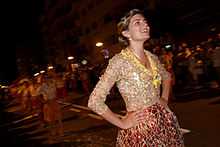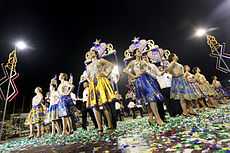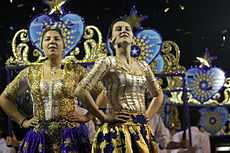Tricana poveira

Tricana poveira is a traditional style of women's clothing from the Portuguese city of Póvoa de Varzim. This look, consisting of colorful costumes, was fashionable and mainstream from the 1920s to the 1960s. Women who dressed in the Tricana poveira style became known as tricana girls.
Description

During tricana's heyday, a tricana girl would typically wear a shawl, an apron, a skirt, a handkerchief and glossy high-heeled slippers.[1][2]
They were thought of as Povoan beauty icons. The author José de Azevedo, referring to their peculiar way of walking and dressing, called tricanas common people with the mannerisms of royalty.[3]
Even though the fashion was based on traditional fishers' clothing, the Tricanas were generally from a blue collar background, often daughters of shoemakers, carpenters or similar craftsmen, while many worked as tailors themselves. They applied their knowledge derived from their background in fashion-related industries to their own dressing style. Bairro da Matriz quarter was famed for its charming and attractive tricanas.[3]
Meanwhile, women actually working in the fishing industry would wear their traditional costumes. Though dressed similarly to the tricana girls, they were visibly poorer and wore longer skirts made of lower-quality materials and in darker colors.[3]
Hair texturing techniques are also relevant to the style and follows traditional Povoan techniques, most notably the pulling of the hair called puxo.[4]
Color code
During parades, tricanas from the six traditional quarters wear dresses in their neighborhood colors.[1]
| Quarter (Bairro) | Tricana dressing color code |
|---|---|
| Bairro Norte | Blue and yellow |
| Bairro Sul | Green and white |
| Bairro da Matriz | Red and white |
| Bairro da Mariadeira | Red and yellow |
| Bairro de Belém | Blue and white |
| Bairro de Regufe | Red and green |



History
The tricana style's heyday was between the 1920s and the 1960s, when it had a strong impact both within Póvoa de Varzim and on outsiders visiting the city.[3]
Tricana costumes were main stream fashion amongst middle class teenagers until the appearance of ready-to-wear clothing in the 1970s. As younger people adopted more modern international fashions, tricana poveira now only appears in urban folklore groups and parades.[3]
Nowadays, tricana costumes can be quite expensive depending on the preferences of the tricana girl and the materials used. Still kept as a strong tradition, tricana girls during Rusgas de São Pedro (Saint Peter Parades), play a big part in the city's festivities on June 28 and 29.[3]
Tricanas do Cidral (from Bairro da Matriz quarter), the first folklore group based on the tricana style, appeared as early as 1920.[5] Tricanas da Lapa (from Bairro Sul quarter) banded together in 1952, Rancho Estrela do Norte in 1954[6] and the regional Tricanas Poveiras in 1993.[2] Leões da Lapa F.C., the city's south quarter association, has a Miss Tricana contest.[7]
References
- Notes
- ↑ 1.0 1.1 Vera Rodrigues (June 21, 2011). "Bairros com novidades para o S. Pedro". Póvoa Semanário. Retrieved May 9, 2012.
- ↑ 2.0 2.1 "Bairros com novidades para o S. Pedro". CMPV. Retrieved May 9, 2012.
- ↑ 3.0 3.1 3.2 3.3 3.4 3.5 Azevedo 2007
- ↑ "A Arte do Puxo da Tricana". A Voz da Póvoa. June 27, 2012. Retrieved July 4, 2012.
- ↑ "Associação Cultural e Recreativa da Matriz". CMPV. Retrieved May 9, 2012.
- ↑ "55º Aniversário Rancho Estrela do Norte". CMPV. Retrieved May 9, 2012.
- ↑ "Bairro Sul escolhe a Miss Tricana". CMPV. Retrieved May 9, 2012.
- Bibliography
Azevedo, José de (2007). Poveirinhos pela graça de Deus (in Portuguese) (2007 ed.). Câmara Municipal da Póvoa de Varzim. ISBN 9789729146459.
